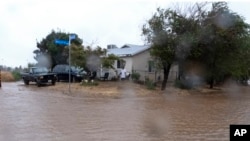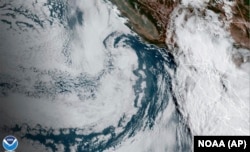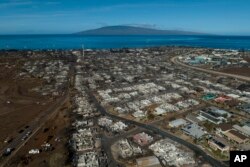The U.S. National Hurricane Center is warning that Tropical Storm Hilary could cause “catastrophic and life-threatening flooding” across Mexico’s Baja California peninsula and into the southwestern United States through Monday.
On Sunday morning, forecasters downgraded Hilary from a hurricane to a tropical storm. Later, they said, however, that Hilary still had sustained winds of 100 kilometers (65 miles) an hour and had made landfall over the Baja California peninsula, about 340 kilometers (215 miles) southeast of the major U.S. city of San Diego, California.
Forecasters said the storm was moving quickly northwestward at more than 40 kilometers (25 miles) an hour and expected to accelerate to an even faster speed. The hurricane center said the storm would reach into the southern regions of California, the most populous U.S. state, by Sunday afternoon.
Tropical storms are common, annual occurrences on the eastern and southern shores of the U.S., but rare in the western states. The last one to strike California was in 1997.
Even as Hilary has weakened, Deanne Criswell, administrator of the U.S. Federal Emergency Management Agency, told CNN’s “State of the Union” show that residents in southern California should take it seriously. “Listen to local officials and make sure it doesn’t put them in harm’s way,” Criswell said.
Some of the flooding threats from Hilary extend into southwestern Arizona and southern Nevada and even further north in the coming days.
Meanwhile, the westernmost U.S. state, Hawaii in the Pacific Ocean, is coping with the aftermath of deadly wildfires two weeks ago that virtually destroyed the historic town of Lahaina on the island of Maui. The blazes have left at least 114 people dead and as many as 1,000 residents still unaccounted for.
President Joe Biden and first lady Jill Biden are scheduled to visit Maui Monday, accompanied by Criswell.
Criswell told CNN that 78% of Maui has now been searched for victims of the wildfires, the deadliest in the U.S. in more than 100 years. Despite the large number of Lahaina residents who are unaccounted for, she held out hope that “it could be they’re staying with friends or relatives.”
She told ABC’s “This Week” show that only 40 survivors of the wildfires remain in shelters, while others who escaped have been placed in hotels, motels and short-term rental facilities on Maui.
She said the task for government officials helping them is to ask, “What are their long-term plans?” She said the answers might be different for everyone.
Criswell said the Bidens will be able to “feel this devastation … and reassure the people of Maui that we are there for them.”
Some Maui survivors have expressed the fear that Lahaina will be rebuilt solely as a tourist mecca with large hotels and shopping catering to the wealthy, rather than as a community of Hawaiians that also is a tourist attraction.
Criswell said it was important for the Bidens and government officials to hear Maui residents and listen to “their version of how they want to rebuild.”










